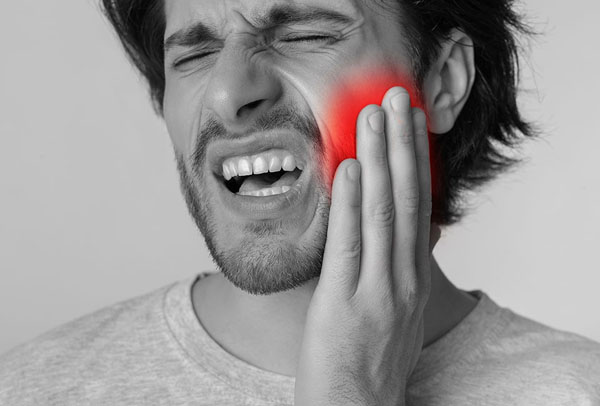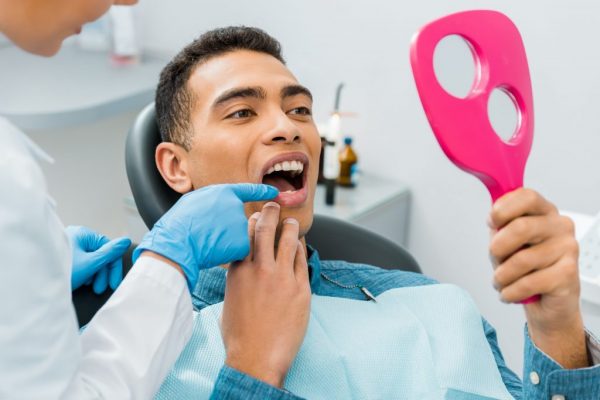Root Canal Therapy in Los Angeles & Studio City, CA
Don’t Live with Tooth Pain– Consider a Painless Root Canal Treatment
Root canal therapy saves a tooth that’s become infected or damaged. While many patients are apprehensive about root canal treatment due to its reputation, it’s a safe way to restore oral health and maintain natural teeth.
In this comprehensive guide, our Los Angeles & Studio City dentist, Dr. Sam A. Lavi, explains the basics of root canal treatment to help patients prepare for treatment and feel more at ease going into their procedures. Contact our dental office today by calling (213) 623-2212 to schedule an appointment.
What Are Dental Infections?

Anatomy of a Tooth
To understand dental infections, it’s helpful to know the basic structure of a tooth:
- Crown: The visible portion of the tooth above the gum line. Enamel, the hardest substance in the human body, covers the crown.
- Dentin: A softer layer beneath the enamel that forms the bulk of the tooth’s structure.
- Pulp: The innermost layer containing nerves, blood vessels, and connective tissue, responsible for tooth development and sensation.
- Root: The part of the tooth anchored within the jawbone. The root canal is a narrow passage within the root that carries nerves and blood vessels to the pulp.
Signs of Dental Infection
Several signs and symptoms may indicate a dental infection. These can include:
- Toothache: A persistent or throbbing pain in the tooth, especially when biting or chewing.
- Sensitivity to hot and cold: Increased sensitivity to hot or cold beverages or food.
- Swollen, tender gums: The gums around the infected tooth may appear red, swollen, and tender to the touch.
- Pus: A discharge of pus (white or yellow) from around the tooth or gums.
- Bad breath (halitosis): Persistent bad breath can indicate an underlying infection.
- Loose tooth: An infected tooth may become loose or shaky.
- Swollen lymph nodes: The lymph nodes in the neck or jaw may become swollen and tender.
- Fever: In some cases, a fever may accompany a dental infection.
If you experience these symptoms, schedule an appointment with Dr. Lavi. Early diagnosis and treatment can prevent the infection from worsening and causing further damage.
What Is Root Canal Therapy?
Root canal therapy is a dental procedure to remove the infected pulp and clean and shape the root canals. The root canals are then filled and sealed to prevent bacteria from reinfecting the tooth. This helps save the tooth and prevent further damage or infection.
When Is Root Canal Therapy Necessary?

- Deep cavity: A cavity left untreated can reach the pulp, causing infection.
- Cracked or chipped tooth: A crack or chip in the tooth can allow bacteria to enter the pulp.
- Repeated dental procedures: Extensive dental work on a tooth can irritate the pulp.
- Gum disease (periodontal disease): In severe cases, gum disease can damage the bone and tissue supporting the tooth, allowing bacteria to reach the pulp.
Benefits of Root Canal Treatment
There are many benefits to undergoing root canal treatment, including:
- Saving the Tooth: Root canal therapy can help save a tooth that would otherwise need extraction.
- Relieving Pain: Root canal therapy can help alleviate pain and discomfort caused by infection or damage to the pulp.
- Preventing Further Damage: By removing the infected or damaged pulp, root canal therapy can prevent further damage to the tooth and surrounding tissue.
- Restoring Function: With a filling in place, a tooth that has undergone root canal therapy can be fully restored and function like a natural tooth.
The Root Canal Treatment Process
Here’s what you can expect with a root canal treatment:
- X-rays: Our dentist will first take an X-ray to see the shape of the root canals and determine if there are any signs of infection in the surrounding bone.
- Dental Sedation: A local anesthetic is administered to numb the tooth. This is done to make the procedure more comfortable for the patient. If you’re extra nervous, talk to your dentist to see if they offer dental sedation options.
- Pulpectomy: A hole is drilled into the tooth to create an opening. We’ll use specialized tools to remove the pulp, bacteria, decayed nerve tissue, and related debris from inside the tooth and its root canal.
- Cleaning and Shaping: After the pulp has been removed, our dentist will clean, enlarge, and shape the canals to prepare them for the filling. This process is usually accomplished with tiny files, and a disinfecting solution may be used to kill any remaining bacteria and wash away debris.
- Filling the Canals: Once the canals are cleaned, they’re sealed with a biocompatible material, usually a rubber-like material called gutta-percha. The gutta-percha is placed with adhesive cement to ensure complete sealing of the canals.
- Temporary Filling: A temporary filling material is placed on top of the gutta-percha to close the opening until the tooth is ready for its permanent restoration. We’ll remove this temporary filling before the tooth is restored.
- Restoration: After healing, the tooth will need a permanent restoration, such as a dental crown or a filling, to replace the lost tooth structure and provide a complete seal to the top of the tooth. This step is crucial to protect the tooth from infection or breaking in the future and to restore its function.

Aftercare for Root Canal Treatment
Following proper aftercare instructions is crucial for optimal healing and the long-term success of your root canal treatment. Here are some general aftercare tips:
- Manage discomfort: Over-the-counter pain relievers can be used to manage any mild discomfort following the procedure.
- Practice good oral hygiene: Maintain a regular brushing and flossing routine to promote healing and prevent future infections.
- Avoid strenuous chewing: Avoid chewing hard foods on the treated tooth until it’s fully restored with a permanent crown.
- Follow-up appointment: Attend your scheduled follow-up appointment with your dentist to ensure proper healing and evaluate the need for a permanent restoration.
Other Endodontic Treatments in Los Angeles & Studio City
There are several types of endodontic treatment, and the type you receive will depend on your specific dental needs. Common endodontic treatments include:
- Apicoectomy: In some cases, root canal therapy may not be enough to treat the infection or damage to the tooth. In these cases, an apicoectomy may be necessary. This involves removing the root’s tip and any infected tissue and sealing the root to prevent further infection.
- Pulp Capping: If the damage to the tooth is minor and hasn’t caused an infection, your dentist may recommend a pulp capping procedure. This involves placing special material over the damaged pulp to help it heal and prevent further damage.
- Regenerative Endodontics: This newer type of root canal therapy helps the damaged pulp in young teeth heal and regenerate. This involves using special materials to stimulate the growth of new pulp tissue and blood vessels in the tooth.
- Root Canal Retreatment: In some cases, a tooth that has undergone root canal therapy may become infected again. In these cases, non-surgical root canal retreatment may be necessary to remove the infection and restore the tooth.
Frequently Asked Questions
Yes! Root canal therapy is considered safe. The treatment involves removing the infected or damaged pulp from the tooth’s root canal and then filling it with a biocompatible material.
Root canal therapy can be done on most teeth, but there may be some exceptions. Teeth with severe decay, extensive damage, or fractures may not be suitable for root canal treatment. In some cases, a tooth may need extraction instead.
Generally, a root canal procedure can be completed in one or two visits. The duration of root canal treatment can vary depending on the tooth’s complexity and the extent of the damage. After the root canal treatment, the tooth may need to be restored with a crown or filling to protect it and restore its function.
Here are the potential consequences of skipping a root canal on an infected tooth:
- Increased Pain and Discomfort
- Spread of Infection
- Bone Loss
- Tooth Loss
- Serious Health Risks
Say Goodbye to Tooth Pain with Gentle Root Canal Therapy
Root canal therapy may seem intimidating, but with the correct information and a qualified dentist, it can be a safe and effective way to treat various dental problems. By understanding what it is, how it’s done, and when necessary, you can make informed decisions about your dental health and get the care you need to keep your smile healthy and bright.
Call our Los Angeles & Studio City dental office at (213) 623-2212 to schedule a consultation today. We also welcome patients from Glendale, Burbank, and other Southern California areas.


